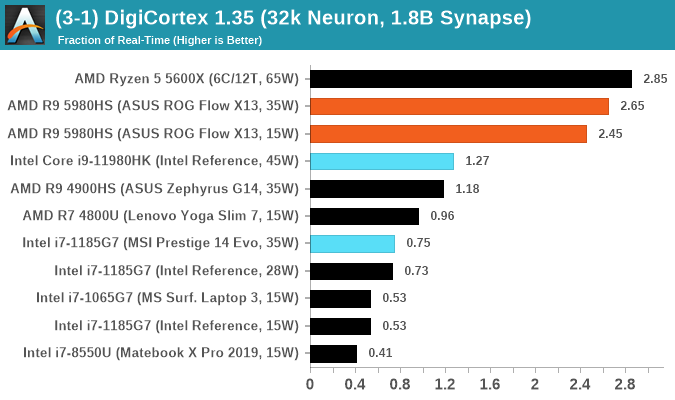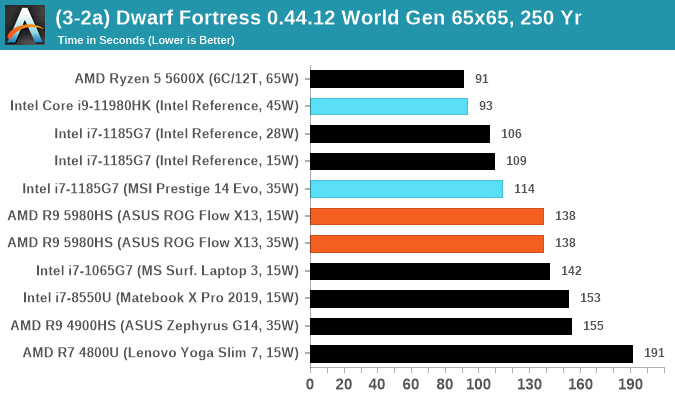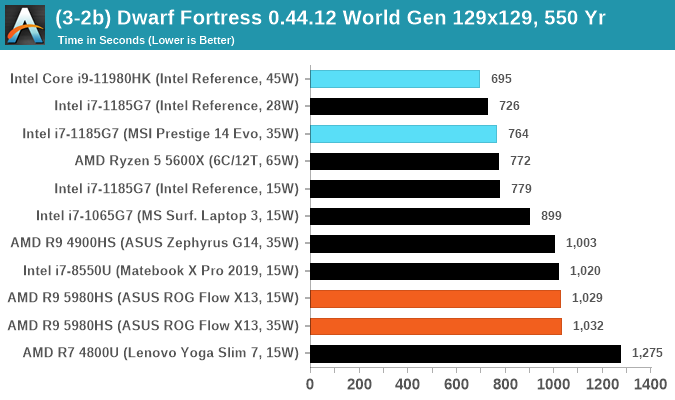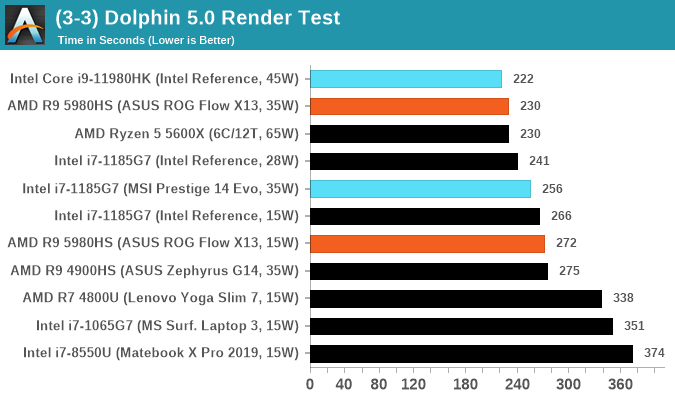Intel 11th Generation Core Tiger Lake-H Performance Review: Fast and Power Hungry
by Brett Howse & Andrei Frumusanu on May 17, 2021 9:00 AM EST- Posted in
- CPUs
- Intel
- 10nm
- Willow Cove
- SuperFin
- 11th Gen
- Tiger Lake-H
CPU Tests: Simulation
Simulation and Science have a lot of overlap in the benchmarking world, however for this distinction we’re separating into two segments mostly based on the utility of the resulting data. The benchmarks that fall under Science have a distinct use for the data they output – in our Simulation section, these act more like synthetics but at some level are still trying to simulate a given environment.
DigiCortex v1.35: link
DigiCortex is a pet project for the visualization of neuron and synapse activity in the brain. The software comes with a variety of benchmark modes, and we take the small benchmark which runs a 32k neuron/1.8B synapse simulation, similar to a small slug.
The results on the output are given as a fraction of whether the system can simulate in real-time, so anything above a value of one is suitable for real-time work. The benchmark offers a 'no firing synapse' mode, which in essence detects DRAM and bus speed, however we take the firing mode which adds CPU work with every firing.
The software originally shipped with a benchmark that recorded the first few cycles and output a result. So while fast multi-threaded processors this made the benchmark last less than a few seconds, slow dual-core processors could be running for almost an hour. There is also the issue of DigiCortex starting with a base neuron/synapse map in ‘off mode’, giving a high result in the first few cycles as none of the nodes are currently active. We found that the performance settles down into a steady state after a while (when the model is actively in use), so we asked the author to allow for a ‘warm-up’ phase and for the benchmark to be the average over a second sample time.
For our test, we give the benchmark 20000 cycles to warm up and then take the data over the next 10000 cycles seconds for the test – on a modern processor this takes 30 seconds and 150 seconds respectively. This is then repeated a minimum of 10 times, with the first three results rejected. Results are shown as a multiple of real-time calculation.

Dwarf Fortress 0.44.12: Link
Another long standing request for our benchmark suite has been Dwarf Fortress, a popular management/roguelike indie video game, first launched in 2006 and still being regularly updated today, aiming for a Steam launch sometime in the future.
Emulating the ASCII interfaces of old, this title is a rather complex beast, which can generate environments subject to millennia of rule, famous faces, peasants, and key historical figures and events. The further you get into the game, depending on the size of the world, the slower it becomes as it has to simulate more famous people, more world events, and the natural way that humanoid creatures take over an environment. Like some kind of virus.
For our test we’re using DFMark. DFMark is a benchmark built by vorsgren on the Bay12Forums that gives two different modes built on DFHack: world generation and embark. These tests can be configured, but range anywhere from 3 minutes to several hours. After analyzing the test, we ended up going for three different world generation sizes:
- Small, a 65x65 world with 250 years, 10 civilizations and 4 megabeasts
- Medium, a 127x127 world with 550 years, 10 civilizations and 4 megabeasts
- Large, a 257x257 world with 550 years, 40 civilizations and 10 megabeasts
DFMark outputs the time to run any given test, so this is what we use for the output. We loop the small test for as many times possible in 10 minutes, the medium test for as many times in 30 minutes, and the large test for as many times in an hour.


Dolphin v5.0 Emulation: Link
Many emulators are often bound by single thread CPU performance, and general reports tended to suggest that Haswell provided a significant boost to emulator performance. This benchmark runs a Wii program that ray traces a complex 3D scene inside the Dolphin Wii emulator. Performance on this benchmark is a good proxy of the speed of Dolphin CPU emulation, which is an intensive single core task using most aspects of a CPU. Results are given in seconds, where the Wii itself scores 1051 seconds.













229 Comments
View All Comments
danjw - Monday, May 17, 2021 - link
No, not really. This is Intel's REFERENCE SYSTEM and it only trades blows with an AMD system that is a product. How is this competitive? You have to realize that the fans on this system aren't tuned for a consumer, they are tuned to make Intel's processor look better. If you read Andrei's conclusions, it is a processor for a laptop no one is selling anymore. It is a 65W processor battling a 35W processor.Their are two reasons this may sell well. AMD's systems are still hard to find and the fact that many consumers still believe that the Intel Inside label is important.
mode_13h - Monday, May 17, 2021 - link
> You have to realize that the fans on this system aren't tuned for a consumer,> they are tuned to make Intel's processor look better.
Not to argue with your main point, but it's worth noting that even when Intel gets to design their own thermal solution, it still fell on its face @ the stock 65W settings. That's pretty bad.
mode_13h - Monday, May 17, 2021 - link
Maybe they should've had the team design it who rigged up that Cascade Lake workstation demo to run all cores at like 5 GHz. Sure, it'd have been the size of a briefcase and sounded like a leaf blower, but at least the it'd clock well!Andrei Frumusanu - Monday, May 17, 2021 - link
Just to make it clear and visible: The i9-11980HK is advertised as a default 45W CPU. The fact that the system came in 65W mode shouldn't be seen as a "stock" behaviour of that SKU.mode_13h - Monday, May 17, 2021 - link
> The fact that the system came in 65W mode shouldn't be seen as a "stock" behaviour of that SKU.So, what are we to make of it? Was Intel trying to rig the benchmarks, then ???
jospoortvliet - Wednesday, May 19, 2021 - link
Pfffif they were they did it in a stunningly incompetent way... hahaSpunjji - Thursday, May 20, 2021 - link
@mode_13h - they did that with their previous Ice and Tiger Lake reference platforms (100% fan speed constantly, yes please) so it makes sense they did the same again here. 😬morello159 - Monday, May 17, 2021 - link
Another thing to consider is that Intel platforms have been much more stable, for me, than AMD. My ASUS G14 with the Ryzen 4900HS, for example, *can* deliver both outstanding battery life and amazing performance. However, there are often times when the system draws extra power for seemingly no reason. There are whole forums dedicated to tweaking the G14's power settings to fix high idle draw. I've also experienced some weird freezes, lockups, etc. It's a great laptop, but I wouldn't use it in a professional setting where I need it to work all the time.My i7-10810U powered Dell Latitude 9510, while quite slow in comparison, gets 12 hours of battery life every time and can run days at a time without any hiccups.
Hifihedgehog - Monday, May 17, 2021 - link
> "Intel platforms have been much more stable, for me, than AMD"LOL. Even with Xe, I still see major graphical issues with 3D games which in some cases even refuse to render. It has gotten way better than five years ago, but AMD's graphic drivers are still far and away better. Stop reaching...
Spunjji - Tuesday, May 18, 2021 - link
This reply doesn't really contradict morello159's main point, though.I've had similar experiences - my 8th gen Intel Dell work system is rock solid, if unspectacular.
My 4800H + 5600M Dell gaming system has... issues. A lot of them appear to be Dell's fault, TBH, but not all of them are.